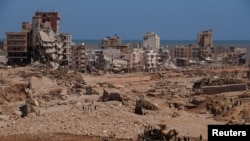Libyan authorities sealed off an inundated city on Friday to allow search teams to dig through the mud and hollowed-out buildings for 10,000 people missing and feared dead after the official toll from flooding soared past 11,000. Authorities warned that disease and explosives shifted by the waters could take yet more lives.
Two dams collapsed in exceptionally heavy rains from Mediterranean storm Daniel early Monday, sending a wall of water several meters high gushing down a valley that cuts through the city of Derna.
The unusual flooding and Libya's political chaos contributed to the enormous toll. The oil-rich state has been split since 2014 between rival governments in the east and west backed by various militia forces and international patrons.
The disaster has brought rare unity, as government agencies across Libya's divide rushed to help the affected areas. But relief efforts have been slowed by the destruction after several bridges that connect the city were destroyed.
Heaps of twisted metal and flooded cars littered Derna's streets, which are caked in a tan mud. Teams have buried bodies in mass graves outside the city and in nearby towns, Eastern Libya's health minister, Othman Abduljaleel, said.
But officials worried that thousands of bodies were still hidden in the muck — or floating in the sea, where divers were sent to search.
Adel Ayad, a survivor of the flood, recalled watching as the waters rose to the fourth floor of his building.
"The waves swept people away from the tops of buildings, and we could see people carried by floodwater," among them his neighbors, he said.
Health officials warned that standing water opened the door to disease — but said there was no need to rush burials or put the dead in mass graves, as bodies usually do not pose a risk in such cases.
"You've got a lot of standing water. It doesn't mean the dead bodies pose a risk, but it does mean that the water itself is contaminated by everything," Dr. Margaret Harris, spokeswoman for the World Health Organization, told reporters in Geneva. "So you really have to focus on ensuring that people have have access to safe water."
Imene Trabelsi, a spokesperson for the International Committee of the Red Cross, warned that another danger lurked in the mud: landmines and other explosive remnants left behind by the country's protracted conflict.
There are leftover explosives in Libya dating back to World War II, but most of the remaining ones are from the civil conflict that began in 2011. Between 2011 and 2021, some 3,457 people were killed and wounded by landmines and explosive weapon remnants in Libya, according to the international Landmine and Cluster Munition Monitor.
Even before the flooding, Trabelsi said the "efforts and the capacity" to detect and demine areas were limited. After the floods, she said, explosive devices may have been swept to "new, undetected areas."
To allow emergency crews to do their work, residents were being evacuated from Derna and only search-and-rescue teams would be allowed to enter, Salam al-Fergany, director general of the Ambulance and Emergency Service in eastern Libya, announced late Thursday.
The Libyan Red Crescent said as of Thursday that 11,300 people in Derna had died and another 10,100 were reported missing. The storm also killed about 170 people elsewhere in the country.
Officials have said that Libya's political chaos has contributed to the loss of life.
"Government institutions are not functioning as they should," Lori Hieber Girardet, the head of the risk knowledge branch the U.N. Office for Disaster Risk Reduction, told The Associated Press on Thursday.
Khalifa Othman, a Derna resident who is searching desperately for missing loved ones, said he blamed authorities for the extent of the disaster.
"My son, a doctor who is graduated this year, my nephew and all his family, my grandchild, my daughter and her husband are all missing, and we are still searching for them," he said. "All the people are upset and angry — there was no preparedness."







